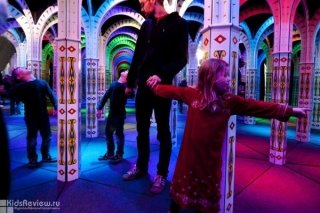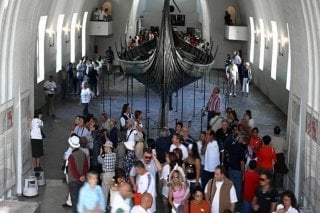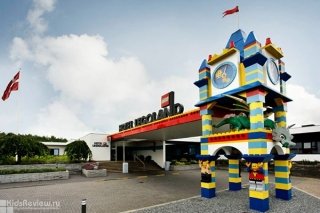Things to do in Copenhagen with kids: ideas for a family vacation in Copenhagen, Denmark
Old entertainment parks Tivoli and Bakken, a zoo and Blue Planet Oceanarium, a Kids Art Museum and a museum with circus trainings, royal gardens, and unusual play centers for kids – when it comes to where to spend time in Denmark and its outskirts, we’ve got it all broken down for you.
.jpg)
Photo by: Ingrid0804 https://www.flickr.com/photos/69839820@N00/
Interesting museums for kids in Copenhagen
Presented in the National Museum of Denmark are various exhibits of art and ethnographic collections as well as kids interactive exhibits. In Grandpa’s Class, they’ve re-enacted a school environment from the 1920s, in Grandpa’s Closet they try on all kinds of old outfits, and in Viking World there is a 6.5 meter ship that they let kids play around in. Admission to the National Museum of Denmark is free.
.jpg)
Photo by: Cláudia Tavares https://www.flickr.com/photos/bemsimples/
About 500 record setting exhibits are presented at Guinness Museum: wax figures of the tallest, the fattest, and the most unusual people in the world; some of the biggest buildings in the world along with an exhibition called Mystic Exploratorie where you call shout and hear an echo in an endless well or catch your own shadow. Also a part of this museum is Ripley’s Museum encompassing strange objects people have created like a rotating tunnel and the tools of a vampire hunter. In Ripley’s Museum you can also end up in the stories of Andersen and see a girl with some matches, Thumbelina, and the Little Mermaid.
An exhibition called Living Planet with a model of the solar system and shards of meteorites is open at Tycho Brahe Planetarium. The museum features and exhibition called A Journey into Space where you can see the Earth from a height of 400 km, watch how astronauts live and work on the international space station, and turn the globes of the planets of our Solar System. There are films about space, the planets, and constellations in a large sphere-shaped hall in IMAX format in Danish; they also rent headphones with an English version as well at the entrance of the theater (payment required).
.jpg)
Photo by: Stephanie Serino https://www.flickr.com/photos/stephaniestravels/
In the Zoological Museum is an Evolution Hall, a Mammoth Halls, and a nature zone diorama. At an exhibit called Magasinet, you can pick up a skull and analyze it or pet an effigy of a hog, a badger, a mole, and other animals. Also located nearby is the Geological Museum where they give you an in-depth look at the earth’s crust and show you why volcanoes erupt. They also have a rather large collection of minerals, prehistoric fossils, and dinosaur bones.
In the small Circus Museum behind the permanent exposition hall, children get to dress up in the outfits of circus performers, walk on top of a rope, and juggle balls. In the summer time on Sundays they organize circus workshops for the whole family on juggling, walking on a rope, and doing trapeze tricks.
There is a large fun room in the Workers Museum. Part of the exhibition is also a real apartment where several generations of a worker family used to live by the name Sorensen. You can also check out how workers live after the war there and check out how the production process at a factory used to go and how workers meetings were held in the past century.
.jpg)
Photo by: https://www.facebook.com/arbejdermuseet.dk/
Playing exhibit Inside the Stamp is open every day at the Post Museum. You can run around there, play and end up in boat on a “raging ocean” out of the soft blue-colored balls, and the exhibits walls are designed with enlarged images of collectable stamps. In the museum itself are old telephones, radios, and computers that they let you touch. Entrance into the museum is free.
The Outdoor Museum is a whole village with residential buildings, workshops, a school, a mill, and a church. You can roll your kids around the village museum on a stroller and if you have older kids, you can take them to a workshop or participate in traditional entertainment. The museum is open from May to October and on Easter (Easter holidays in Denmark and Russia are celebrated at different times).
.jpg)
Photo by: https://www.facebook.com/frilandsmuseet/
There are collections of professional drawings and sculptures from different countries in the Danish Arts Museum. Entrance into the permanent exposition is free and tickets will be required to enter the temporary ones. In the gallery called European Arts 1300-1800, you can play a board game called Match-SMK and they also have a whole Kids Arts Museum with tours for kids, an arts school, and lessons on drawing and modeling.
Entertainment for kids in Copenhagen
There is always something going on year round at Tivoli Gardens: during the warm season there are attractions and peacocks walking though the lawns, in the fall the whole park is covered in Halloween decorations, and in winter they celebrate Christmas. They have old and contemporary attractions there, video game machines, a Ghost Hotel, and other entertainment for the whole family.
.jpg)
Photo by: Ole Gjoerup https://www.flickr.com/photos/ole_g/
You can also check out the deer living in at Dyrehavsbakken in the suburbs of Klampenborg. The park is most famous as Bakken. It is one of the oldest attraction parks in the world that is still in operation. You can go for a ride on both the old and the stylized merry-go-rounds as well as roller coasters during the warm season and the park, restaurants, and “indoor” entertainment are open year round.
Experimentarium Science Entertainment Center is located in the suburbs of Hellerup. Open for schoolchildren are play stations, such as the Kids Peacocks, for a little bit older kids they have the Circus Physicus galleries with swinging pendulums and carpet planes, You and Me with “hygienic mirrors” and aroma palettes, and Now You Listen with huge hears that help you hear what people are saying in other galleries. In Experimentarium, you can turn on, smell, listen to, and conduct science experiments on any of the 300 exhibits from the permanent exhibition.
.jpg)
Photo by: https://www.facebook.com/experimentarium/
At Himmelhoj play station in Vestamager nature center in the southern part of the city, you can play hide and go seek in the Fox Burrow, feel like a little bug in the giant Insect Forest, and go through a maze and end up at the Amager Ark. There are places set up all around the playground to start up a bonfire where you can even cook some food or just sit around it and chat.
Operating at Felled Park is a kids automobile town called Trafiklegeplads where you can go for a ride on a bicycle, a go cart, or an electromobile in a play traffic zone with pedestrian crossings, intersections, and traffic lights. The park is currently being rebuilt and they promise that it will reopen in the spring of 2014. There are plat stations for children in Felled Park and in the summer it opens up a skate park as well.
One good outdoor activity for your kids to try would be at Klatreskoven Rope Park. It has 5 courses for all different levels and ages: a yellow course for children 3 and up, for a little bit older kids they have a green one, and the black course is for more experienced rope climbers. They have some unusual obstacles as well, for example in one of the courses you have to climb through the interior of a car stuck between trees.
Places to take your kid for a walk in Copenhagen: parks and gardens of Copenhagen
In Felled Park, where a kids automobile town is located, there are several play stations as well, for example in the form of a fortress. Also in the park is a Mirror House: part of its façade is fronted with polished steel sheets making it look like one huge mirror (the building is located right inside the park at the Blegdamsvej/Frederik V vej intersection).
There are kids play stations in Ersted Park and in the city’s biggest Valby Park with a rose garden. Open in the Royal Garden in front of Rosenborg castle is a kids playground with a slide in the form of a dragon, wooden fairy tale characters, and golden eggs.
.jpg)
Photo by: https://www.flickr.com/photos/152416309@N02/
You can walk through greenhouses and check out secular trees and giant lily pads at the Botanical Garden. In the summer time they do drawings as well. You can rent a few drawing tools for free at Maskinhallen and at the pond in the Palm Greenhouse they have Nature Workshops for the whole family. Entrance into the Botanical Garden is free.
You can see the symbol of Copenhagen, a Mermaid Monument and the Gefion Fountain with sculptures at Langelinie Park. Langelinie is easiest to get to by taking a ferry: It’s located at the city harbor and it has a kids play station inside it as well.
Superkilen, probably the most unusual city park, was crashed in the northeast part of the city in Norrebro. Collected at the park are objects from 108 different countries, the resident of which all settled in in Norrebro: there is a kid’s slide there in the form of a Japanese octopus, a fountain from Morocco, a Russian pavilion, and benches from Iran and Brazil. Meanwhile, each object is signed in Danish to the country that brought it there. The park is divided into three color zones: the red zone is for doing sports, the black zone is to set up meetings, and the green zone is for having picnics and playing moving games.
.jpg)
Photo by: https://www.facebook.com/Superkilen-153542751360190/
Scattered across the royal estate, Amalienborg Palace, is Amaliehavn Garden where you can go for a walk at sit at the fountain on the embankment. Also starting every day at exactly 12:00 is the triumphant substitution of the royal watchmen on the square in front of the palace.
You can also go for a walk through Stroget Pedestrian Zone, which is considered the largest pedestrian street in the world. Be ready for unexpected expenses: there are many cafés open on Stroget as well as restaurants and shops. Furthermore, it will be tough to leave the main shop, known as Lego, or the only Disney shop in Scandinavia without appeasing your kid without a new toy to play with.
There are ships departing Nyhavn, the “New Harbor”, for tours along the rivers and canals of Copenhagen with an audio guide in 11 different languages (including Russian). You can also buy a daily pass, which is valid in all river routes in the course of 24 or 48 hours. There are discounts available for boat rides during the winter as well and you can find out the exact prices on the city’s website: Canal Tours Copenhagen stromma.dk/en/CANALTOURS.
.jpg)
Photo by: Toni de Ros https://www.flickr.com/photos/12623755@N02/
There are no more Free Bikes that you used to be able to rent in Copenhagen: the project was closed in 2012. There is currently a campaign going in the city to return project City Bike and you can find out the latest news on it on gobike.com.
Copenhagen Zoo and Aquarium
The Copenhagen Zoo is open year round in the suburbs of Frederiksborg. This zoo is divided into various theme zones: Northern Nature, South America, The Tropics, Asia and Africa, and there is also a Kids Petting Zoo. The most unusual open-air cage is the Arctic Ring is located at the entrance: in 2012 an underwater tunnel where you can watch polar bears and penguins swimming. There is also a Tasmanian devil living in this zoo – the only one outside of Australia.
In the spring of 2013, the largest oceanarium in Northern Europe opened up for business called Blue Planet just 2 km from Kastrup Airport. It features various theme zones with outdoor and indoor aquariums, which is inhabited by over 20 thousand different underwater creatures. You can also watch sharks swim around in the Ocean Zone, find clownfish and dragonfish in Coral Reef, cross over ponds on a bridge in Amazonia, and pet a starfish or a crab in the Cold Water Petting Aquarium.
.jpg)
Photo by: Riemanello https://www.flickr.com/photos/rriemann/
Copenhagen observation decks
One of the most famous observation decks in Copenhagen is located on Round Tower at a height of about 35 meters. You don’t take a staircase up there, yet instead there is a spiral lift instead, which has previously lifted horses and even cars. Open at the upper tier is a planetarium and a public observatory where anyone can look into a telescope (in the Danish version of the observatory site is a schedule on the days that certain stars and planets will be the most visible).
The observation deck on the tower of the Church of Our Savior is located at a height of 86 meters. You can go up there and check out Kristianhavn Island year round in good weather, including the church itself, and if you’re lucky you might catch an organ or a carillon concert.
.jpg)
Photo by: Megan Stoehr https://www.flickr.com/photos/7959146@N08/
You can get a beautiful view of the Old City from a height of 105 meters at the deck of the City Hall. The City Hall, of course, is the location where the city council operates, but some of the rooms are open to visitors. One of the rooms, for example, is the Jens Olsen astronomical clock room with a model of the Solar System demonstrating the motion of the planets around the Sun. According to this clock, you can find out the time at any point of the planet.
How to save money in Copenhagen: A tourist map of Copenhagen Cards and free museums in Copenhagen
A trip to Copenhagen, especially with your whole family, can run you a lot of money. There are, however, several ways to keep from spending more money than you have to.
There are special picnic zones (usually marked by a Picnic Area sign) designated in practically all public places, museums, and parks where you can bring food and have lunch.
There are very few free museums in Copenhagen. The National Museum of Denmark and its branches offer free admission for everyone and the main museum provides free tours in English as well. Another free place you can get in is the permanent exhibition at the National Gallery and the Post Museum in the Botanical Garden as well as Bakken Theme Park (attractions paid separately).
.jpg)
Photo by: John Dalkin https://www.flickr.com/photos/59303791@N00/
Tourists that are interested in visited as many places as possible should consider buying a Copenhagen Card. Included in the Cost of the Copenhagen Card is public transportation around the city and its suburbs as well as discounts for restaurants, shops, car rental, and free entrance to 75 different attractions. You can see the full list of what the Copenhagen Card covers at copenhagencard.com/whats-included.
If an adult buys his or herself a Copenhagen card, then he is also able to take one or two kids between the age of 0 and 9 around with him or herself for free. You can buy the card right inside the airport (the cost of getting to the city from the airport is also included in the price), at train stations, at tourist information centers, and several hotels. The cost of different types of cards for October 2013 is listed in the table below (in Danish crowns and converted into rubles).
|
Card validity |
Adult |
Child (10-15 years old) |
|
1 day (24 hours) |
299 crowns – 1,750 rubles |
159 crowns – 930 rubles |
|
2 days (48 hours) |
449 crowns – 2,630 rubles |
199 crowns – 1,165 rubles |
|
3 days (72 hours) |
529 crowns – 3,100 rubles |
239 crowns – 1,400 rubles |
|
5 days (120 hours) |
749 crowns – 4,390 rubles |
349 crowns – 2,050 rubles |
We’ve also found out how to get out to the country from Copenhagen. You can read about that in our second review.



Comments and reviews (0)
Before leaving a comment please have a look at our rules.